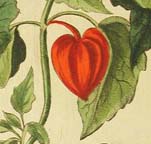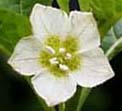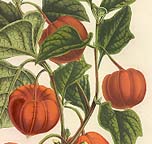 Physalis alkekengi
(franchetii) var. gigantea Physalis alkekengi
(franchetii) var. gigantea
Giant Chinese Lanterns
A member of the
Nightshade family, this wonderfully cheerful magick herb is associated
with Venus on
account of its bright orange-red lanterns, which sometimes give the
plant the name "Love in a Cage." The lanterns are great for
love magick and make wonderful cut or dried flowers because they keep
their color for a long time, being especially good to see on gloomy
fall days. The plant's small white flowers are pollinated by bee s. The
calyxes, or lanterns, which begin to form as the flowers fade, are
first a brownish green and then turn to scarlet as they mature. Inside
is a red berry. The dead ripe fruit (not the lantern) is edible but
doesn't taste very good--it is sour on account of having more vitamin C
than lemons. The rest of the plant, especially the leaves and unripe
berries, is poisonous and can even be fatal if eaten, containing
solanine, the same stuff that makes green potatoes and tomato leaves
poisonous. In spite of this, in Traditional Chinese Medicine, the calyx
and fruits are used against toxic heat, for sore throats, and for thick
coughs; they are also pounded into a paste that is spread on eczema. A
homeopathic remedy made from the fruit is used in kidney and bladder
disease. In Europe, the ripe berries are macerated in wine or vodka to
make an extract that is taken for bladder infections. Western
allopathic medicine is investigating the anti-tumor capabilities of
this plant. Harvest the lanterns for drying when the leaves begin to
fade. This plant is also known as Japanese Lantern, Winter Cherry,
Strawberry Tomato, Jews' Cherry(!), and Love In a Cage. Top s. The
calyxes, or lanterns, which begin to form as the flowers fade, are
first a brownish green and then turn to scarlet as they mature. Inside
is a red berry. The dead ripe fruit (not the lantern) is edible but
doesn't taste very good--it is sour on account of having more vitamin C
than lemons. The rest of the plant, especially the leaves and unripe
berries, is poisonous and can even be fatal if eaten, containing
solanine, the same stuff that makes green potatoes and tomato leaves
poisonous. In spite of this, in Traditional Chinese Medicine, the calyx
and fruits are used against toxic heat, for sore throats, and for thick
coughs; they are also pounded into a paste that is spread on eczema. A
homeopathic remedy made from the fruit is used in kidney and bladder
disease. In Europe, the ripe berries are macerated in wine or vodka to
make an extract that is taken for bladder infections. Western
allopathic medicine is investigating the anti-tumor capabilities of
this plant. Harvest the lanterns for drying when the leaves begin to
fade. This plant is also known as Japanese Lantern, Winter Cherry,
Strawberry Tomato, Jews' Cherry(!), and Love In a Cage. Top
 How to grow Chinese Lanterns: Direct sow in garden in prepared soil in June or
just barely cover indoors in peat pellets in March/April. Germinates in
14-30 days at 71-75F/22-24C. You can also try growing this like tomato,
from transplanted germinated with warmth. Transplant to 18-24" apart.
Grow in dappled sunlight/light woodland shade. It gets 24-30"/60-75cm
tall. More lanterns are produced when the plant is not crowded, has
rich soil, and gets sufficient sun, but full sun is usually too much
for it. This plant spreads by underground runners that you can divide
in the spring. Chinese lanterns can be aggressive, so grow it in a
container if you don't want it taking over your garden, or you can
surround it with grassy areas. However, this same invasiveness makes it
a good groundcover. Slugs enjoy the young plants, so watch
out for them. This plant is a perennial in zones 3-10 (-40F/-40C). General
growing info Top How to grow Chinese Lanterns: Direct sow in garden in prepared soil in June or
just barely cover indoors in peat pellets in March/April. Germinates in
14-30 days at 71-75F/22-24C. You can also try growing this like tomato,
from transplanted germinated with warmth. Transplant to 18-24" apart.
Grow in dappled sunlight/light woodland shade. It gets 24-30"/60-75cm
tall. More lanterns are produced when the plant is not crowded, has
rich soil, and gets sufficient sun, but full sun is usually too much
for it. This plant spreads by underground runners that you can divide
in the spring. Chinese lanterns can be aggressive, so grow it in a
container if you don't want it taking over your garden, or you can
surround it with grassy areas. However, this same invasiveness makes it
a good groundcover. Slugs enjoy the young plants, so watch
out for them. This plant is a perennial in zones 3-10 (-40F/-40C). General
growing info Top
|
Physalis
alkekengi var. gigantea
Giant Chinese Lanterns
25 seeds $3.75
If you like plants with puffy pods, take a look at Black Apple of Peru
Uses
in Witchcraft & Magic:
Love Spells
Venus Herb
© 2004-2024 Alchemy Works; No reproduction without permission
|